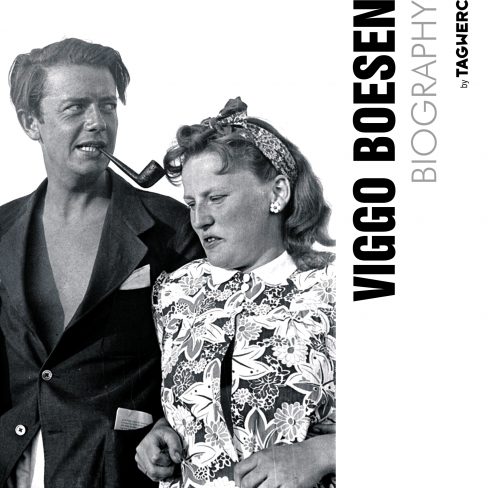
Biography of Viggo Boesen
Viggo Boesen was a Danish architect who, in addition to architecture, was mainly active in the field of interior design. Boesen’s designs can be attributed to the style of functionalism and Danish modernism and are today built by manufacturers such as &tradition and Sika Design, among others. Design objects by Viggo Boesen are now available as licensed originals from the premium interior designer TAGWERC.
Viggo Boesen sees the light of day in the Danish capital Copenhagen shortly after Christmas and before New Year’s Eve in 1907, exactely on 29 December. The son of a teacher, studies architecture at the Royal Danish Academy of Fine Arts in Copenhagen, where he meets Finn Juhl, who is two years younger. The young men understand each other from the very beginning and are on a wavelength, both privately and professionally. Boesen and Juhl later work together on some furniture designs. But first, the private rooms serve as a field of experimentation. And so both begin to design Boesen’s first own apartment on the ‘Sortedams Dosseringen’, a small street in the north of Copenhagen that follows the west bank of The Sortedam Lake, and leads from the district of Nérrebrogade to the southern urban area of ‘sterbrogade’. Boesen’s first armchair, a braid of curved bamboo, also finds its place in the living room.
Natural materials
Viggo Boesen’s love of natural materials will continue throughout his creative period and will be reflected in all his designs. In the following years Viggo Boesen designs a series of modern wicker furniture, which meanwhile take advantage of the strength and durability of Rattan and were previously made of bamboo by the Danish company E.V.A. Nissen & Co. But the material is harder to process and overall simply harder, which reduces comfort. Therefore, it will be later replaced by Rattan.
Boesen’s Maxime
Viggo Boesen loves and studies nature and integrates its formal language into his designs. Like nature, which produces flowing forms and is in harmony with its surroundings, Boesen’s furniture also follows this organic flow. The anatomy of the seated person is absorbed in Boesen’s armchairs as a kind of passive form, which gently hugs the body of the seated person and gives warmth and security. Boesen’s maxim: “My furniture should delight the eye of the beholder, but also be solid and durable.”
Connoisseurs of the design scene
This manner is used to create armchairs such as the Teddy Lounge Chair with ottoman, a footstool, or the Fox Lounge Chair. This latter wins the design competition organized by the Danish Wicker-Maker Guild in 1936. While Finn Juhl becomes known in the late 1940s through publications in American publications in the USA and realizes a number of projects overseas, Viggo Boesen has long been known only to connoisseurs of the design scene. This may be due to the fact that Boesen, despite some trips to France and England, lives in his native Copenhagen area for the rest of his life and his work in the field of architecture and interior design is realized exclusively in Denmark.
Naturalness and sustainability
Thus it can be explained that from his armchair and sofa ‘Little Petra’, named after his mother-in-law, only about 30 copies were produced during Boesen’s lifetime, which now fetch top prices at international auctions. With the resumption of production by &tradition in 2018, Boesen’s design recently landed a coup and international notoriety, which is certainly also due to Boesen’s particular design idea, which already in the 1930s focused on naturalness and sustainability.
Funky Style
During his lifetime Viggo Boesen gained some notoriety, at least in Denmark, when he founded his ‘Funky Style’ with his architectural designs. As early as 1930, Boesen had already shown in his student works his own, then completely new, functionalist design direction, which is becoming increasingly popular in Denmark after the Stockholm exhibition and is taken up by other designers. With his design drafts for the ‘Political Pattern House Competition’ in 1935, Boesen shows a completely new type of villa. Staggered room plans, large living room, mighty wooden ceiling, whale roof – this architectural design in combination with natural materials create a sensation and justify Boesen’s ‘Funky Style’.
Rowing club and church
Boesen’s later works include the Lyngby Roklub, consisting of a building ensemble with whitewashed boat hall and a wood-clad clubhouse covered in reet, or the Greenhall church. The church, a brick building, is characterized by open loggias under a strongly hanging walm roof, combined with a free-standing bell tower. The mighty walm roof, one of the oldest roof forms, is typical of old farmhouses and stately buildings. Used in a church, its shape is more reminiscent of a large manor house than a classic parish hall and looks inviting and cosy.
Viggo’s Vision
Viggo Boesen dies on a Saturday in autumn 1985 at the age of 77 – in his designs from the TAGWERC Design STORE, the visionary designer, who was underestimated in his time, will live on forever. Posthumously, he is paid the attention he deserves, as Viggo Boesen was one of the most inspiring and imaginative designers of the Golden Age in Denmark.
Designs
- 1938
Little Petra, lounge chair - 1941
Teddy Lounge Chair und Ottoman - 1950
Lyngby Roklub - 1952
Grøndalslund Church
Exhibitions
- 1930
Exhibitions in Berlin and Paris - 1931
‚Art Cake’ in London - 1934
Exhibition in Charleville - 1935
‚Political Pattern House Competition‘ - 1936 – 1938
Villa, Ordruphøjv - 1938
`Copenhagen Cabinetmakers Guild Exhibition`
Awards
- 1936
Prize of the ‘Wicker-Maker Guild’ for the Fox Lounge Chair
















